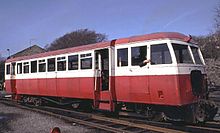County Donegal Railways Joint Committee


The County Donegal Railways Joint Committee operated an extensive 3 ft (914 mm) narrow gauge railway system serving county Donegal, Ireland, from 1906 until 1960. The committee was incorporated by an Act of Parliament in 1906, which authorised the joint purchase of the then Donegal Railway Company by the Great Northern Railway of Ireland and the Midland Railway Northern Counties Committee.
History of the Donegal Railways
On 1 May 1906, the Joint Committee was set up. The lines inherited by the Joint Committee totalled 106 miles (171 km) and were:
- Finn Valley Railway (FVR) from Strabane to Stranorlar
- West Donegal Railway line from Stranorlar to Donegal
- The Donegal Railway Company lines between Stranorlar and Glenties, Donegal Town to Killybegs, Strabane to Derry, and Donegal Town to Ballyshannon
The Joint Committee opened the Strabane and Letterkenny Railway on 1 January 1909, bringing the total mileage to 121 miles (195 km). By 1912 the company owned the following assets:[1]
- Locomotives and rolling stock: 21 locomotives; 56 passenger vehicles; 304 goods vehicles
- Head offices and locomotive works at Stranorlar
The Strabane to Derry line was completely owned by the Midland Railway Northern Counties Committee although it was operated by the CDJRC.[2]
At the height of its extension, the County Donegal Railways Committee operated the largest narrow gauge railway system in the British Isles. The railway was affectionately known as the "Wee Donegal".[3]
Dieselisation

Under the management of Henry Forbes, traffic superintendent from 1910 to 1943, the County Donegal Railways became pioneers in the use of diesel traction.[4] The first diesel railcar was built in 1930 (the first diesel railcar anywhere in the British Isles), although two further petrol-engined railcars were built before standardisation on diesel traction in 1934. Eight articulated diesel railcars were constructed by Walker Brothers of Wigan between 1934 and 1951, by which time virtually all passenger services were operated by diesel railcar. The railcars could only be driven from one end and had to be turned by a turntable to make a return journey. They also couldn't be worked in multiple, if two railcars were working back to back both required a driver. The railcars were incapable of hauling most freight wagons, so steam traction continued to be used on freight and excursion trains. The railcars were powerful enough to haul specially constructed trailers and some lightweight freight wagons, these special wagons were painted red to distinguish them from the heavier wagons which were grey. A diesel locomotive named Phoenix (converted from a steam locomotive) was also used, but due to the noisy and slow speed (top speed of 27 mph or 43 km/h) she spent most of her career shunting and built up a mileage of 204,577 miles (329,235 km) in its working life.[5]
Closure

The Glenties branch closed in 1947, the Strabane-Derry line closed in 1954 and the rest of the passenger services ended on 31 December 1959. Much of the railway was closed on that date. Goods trains ran between Strabane and Stranorlar until 6 February 1960
In 1961, the two most modern diesel railcars were sold to the Isle of Man Railway.
Tourist attraction


Part of the line, which runs alongside Lough Finn near Fintown, has been re-laid as a tourist railway.[6]
The Donegal Railway Heritage Centre has been established and contains historic details and artefacts of the CDRJC.[7]
St. Connell's Museum, in Glenties has an extensive display of items from the railway.[8]
The Foyle Valley Railway in Derry housed numerous CDRJC artefacts, although their future has been uncertain since the museum closed in 2015.
In preservation
Several examples of CDRJC rolling stock has survived into preservation. Some examples are listed below by number, with their present location in brackets:
- Steam locomotives: 2 Blanche (UFTM), 4 Meenglas (FVR), 5 Drumboe (RPSI), 6 Columbkille (FVR)
- Diesel locomotives: 11 Phoenix (UFTM)
- Diesel railcars: 1 (UFTM), 10 (UFTM), 12 (FVR), 15 (DRC), 18 (FTR), 19 (IOMR), 20 (IOMR)
- Carriages: 1 (UFTM), 3 (UFTM), 5 (DRC) 14 (FVR), 28 (DRC), 30 (FVR)
- Goods wagons: 12 (DRC), 19 (FVR), 136 (UFTM), Unidentified horsebox (RPSI), Unidentified Van (DRC)
UFTM = Ulster Folk & Transport Museum; FVR = Foyle Valley Railway; RPSI = Railway Preservation Society of Ireland; FTR = Fintown Railway; DRC = Donegal Railway Centre; IOMR = Isle of Man Railway
See also
References
- ^ Railway Year Book 1912 Railway Publishing Company
- ^ The Industrial Archaeology of Northern Ireland. William Alan McCutcheon, Northern Ireland. Dept. of the Environment, Fairleigh Dickinson University Press, 1984
- ^ Robert Robotham; et al. (1999). The Last Years of 'The Wee Donegal': The County Donegal Railways in Colour 1950–59. Colourpoint Books. ISBN 978-1898392422.
- ^ Britain Between the Wars: 1918–1940. Charles Loch Mowat, Taylor & Francis, 1968
- ^ A History of the Narrow Gauge Railways of North West Ireland Part 1 The County Donegal Railways by Edward M Patterson
- ^ Fintown Railway – An Mhuc Dhubh
- ^ Donegal Railway Heritage Centre
- ^ [1] Archived 19 November 2007 at the Wayback Machine
Further reading
- Architectural Heritage of the Narrow Gauge Railways of County Donegal. County Donegal Railway Restoration Ltd. 2003.
- "North West of Ireland Railway Preservation Society". The Phoenix. 1–23. County Donegal Railway Restoration Ltd. 1992–2005.
- Begley, Joe (1995). The County Donegal Railway A Visitors Guide. ISBN 1-874518-04-1.
- Bell, Dave (2001). County Donegal Railway Restoration Society 10 years.
- Flanders, Steve (1996). The County Donegal Railway An Irish Railway Pictorial. ISBN 1-85780-054-0.
- Crombleholme, Roger (2005). The County Donegal Railways Companion. ISBN 1-85780-205-5.
- Patterson, Edward M. (1969). The County Donegal Railways. ISBN 0-7153-4376-9.
- Donegal's Railway Heritage. Vol. 1 (South Donegal). South Donegal Railway Restoration Society. 1994. ISBN 1-874518-01-7.
